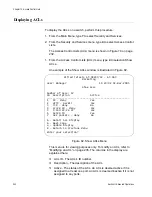
Chapter 14: Class of Service
248
Section II: Advanced Operations
Configuring Egress Scheduling
This procedure explains how to select and configure a scheduling method
for Class of Service. Scheduling determines the order in which the ports
handle packets in their egress queues. Scheduling is set at the switch
level. You cannot set this on a per-port basis.
1. From the Main Menu, type
7
to select Security and Services.
2. From the Security and Services menu, type
5
to select Class of
Service (CoS).
The Class of Service (CoS) menu is shown in Figure 84 on page 244.
3. From the Class of Service (CoS) menu, type
3
to select Configure
Egress Scheduling.
The Configure Egress Scheduling menu is shown in Figure 87.
Figure 87. Configure Egress Scheduling Menu
4. Type
1
to toggle Scheduling Mode between its two possible settings.
The default setting is Strict Priority.
If you select Strict Priority, skip the next step. Options 2 through 9 in
the menu do not apply to Strict Priority scheduling.
5. If you select Weighted Round Robin Priority as the scheduling method,
select menu options 2 through 9 and specify the maximum number of
packets a port can transmit from a queue before moving to the next
queue. The range for Q0 to Q6 is 1 to 15. The range for Q7 is 0 to 15.
Allied Telesis AT-9424T/SP - AT-S63
Marketing
User: Manager
11:20:02 02-Mar-2005
Configure Egress Scheduling
1 - Scheduling Mode ............ Strict Priority
2 - Queue 0 Weight ............. 0
3 - Queue 1 Weight ............. 0
4 - Queue 2 Weight ............. 0
5 - Queue 3 Weight ............. 0
6 - Queue 4 Weight ............. 0
7 - Queue 5 Weight ............. 0
8 - Queue 6 Weight ............. 0
9 - Queue 7 Weight ............. 0
R - Return to Previous Menu
Enter your selection?
Summary of Contents for AT-9400
Page 16: ...Figures 16 ...
Page 18: ...Tables 18 ...
Page 28: ...Preface 28 ...
Page 30: ...30 Section I Basic Operations ...
Page 60: ...Chapter 1 Basic Switch Parameters 60 Section I Basic Operations ...
Page 64: ...Chapter 2 Port Parameters 64 Section I Basic Operations Port Type The port type ...
Page 84: ...Chapter 2 Port Parameters 84 Section I Basic Operations ...
Page 124: ...Chapter 6 Static Port Trunks 124 Section I Basic Operations ...
Page 144: ...144 Section II Advanced Operations ...
Page 196: ...Chapter 10 File Downloads and Uploads 196 Section II Advanced Operations ...
Page 218: ...Chapter 11 Event Logs and the Syslog Client 218 Section II Advanced Operations ...
Page 242: ...Chapter 13 Access Control Lists 242 Section II Advanced Operations ...
Page 294: ...294 Section III IGMP Snooping MLD Snooping and RRP Snooping ...
Page 314: ...Chapter 19 MLD Snooping 314 Section III IGMP Snooping MLD Snooping and RRP Snooping ...
Page 318: ...318 Section IV SNMPv3 ...
Page 416: ...Chapter 21 SNMPv3 416 Section IV SNMPv3 ...
Page 418: ...418 Section V Spanning Tree Protocols ...
Page 470: ...470 Section VI Virtual LANs ...
Page 520: ...Chapter 26 Multiple VLAN Modes 520 Section VI Virtual LANs ...
Page 532: ...Chapter 27 Protected Ports VLANs 532 Section VI Virtual LANs ...
Page 546: ...546 Section VII Internet Protocol Routing ...
Page 560: ...560 Section VIII Port Security ...
Page 568: ...Chapter 30 MAC Address based Port Security 568 Section VIII Port Security ...
Page 586: ...Chapter 31 802 1x Port based Network Access Control 586 Section VIII Port Security ...
Page 588: ...588 Section IX Management Security ...
Page 610: ...Chapter 33 Encryption Keys 610 Section IX Management Security ...
Page 650: ...Chapter 36 TACACS and RADIUS Protocols 650 Section IX Management Security ...
Page 660: ...Chapter 37 Management Access Control List 660 Section IX Management Security ...
Page 668: ...Index 668 ...
















































